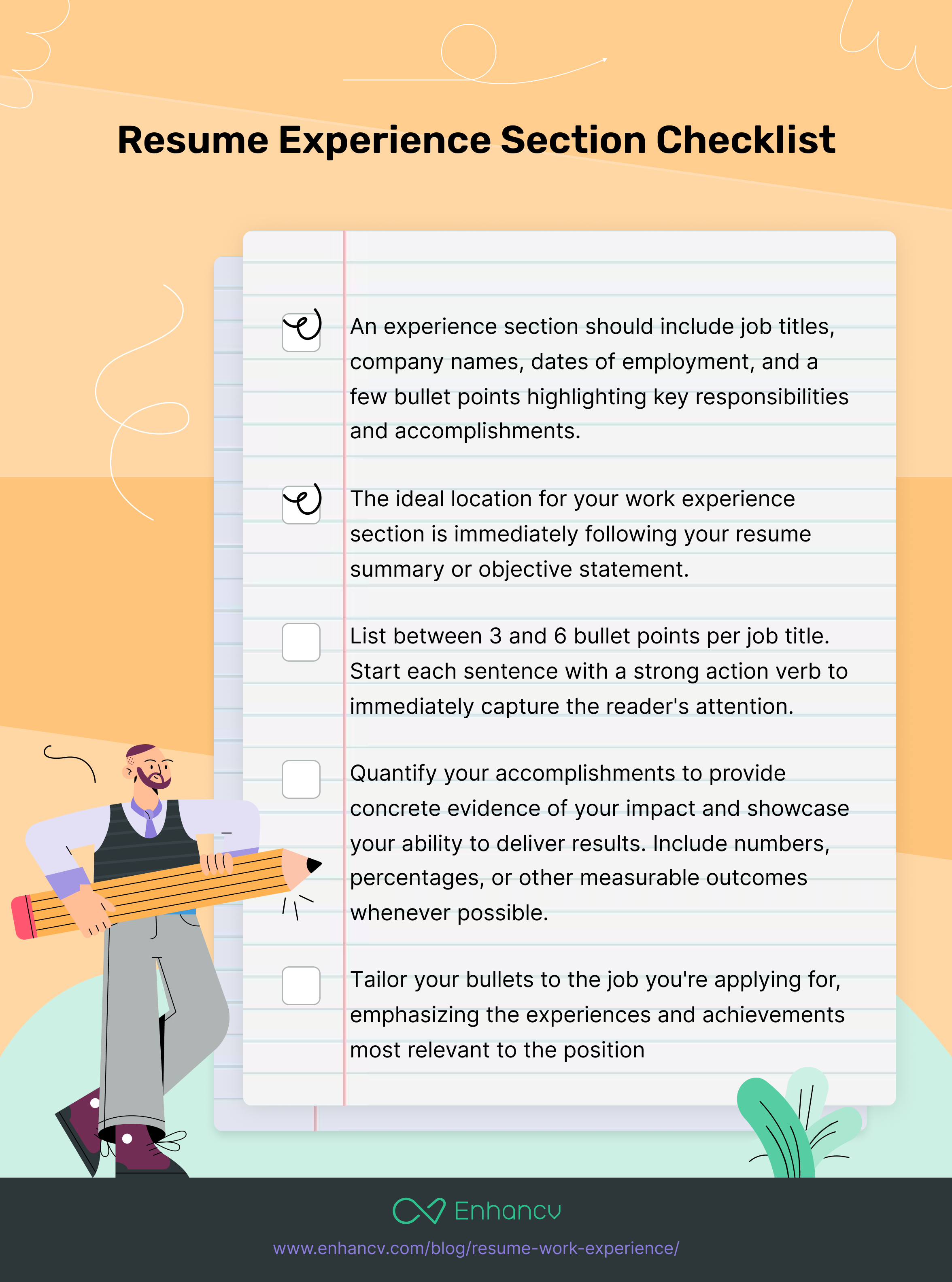Resume work experience almost always needs to be presented in reverse chronological order—starting with your most recent position and working backward.
Each entry needs to include the basics: company name and location; job title; start and end dates. It’s also essential to include bullet points describing your duties and responsibilities.
Finally, never underestimate the power of action verbs and quantifying your accomplishments.
Crafting the perfect resume experience section can be challenging, especially when deciding how to describe work history effectively. Almost everyone struggles with selecting the right work experience examples that highlight their skills and accomplishments. The key is to showcase your professional past in a way that resonates with potential employers.
A well-structured resume work experience example shouldn’t only detail your previous roles but also emphasize the impact of your contributions. By accurately featuring your work experience, you enhance your chances of catching a recruiter's eye and securing your next job opportunity.
We guarantee that by the end of this article, you’ll have a better understanding of this particular resume section and be able to do the following:
- Study and use a plethora of real work experience examples to help visualize your target.
- Easily produce an effective entry that conveys all the essential elements.
- Be able to recognize and correctly choose which format is best for the specific job you’re applying for.
- Understand what exactly needs to be included in your work listing.
- Tips on writing a more powerful and convincing experience section.
- How to properly describe and convey your achievements and responsibilities in an impactful way.
Let’s begin by looking at what exactly we are trying to craft.
Improve your resume experience section!
Drop your resume here or choose a file. PDF & DOCX only. Max 2MB file size.
What is a resume work experience section?
The work experience section is arguably the most critical part of a resume, serving as the focal point for recruiters and hiring managers alike. This segment outlines your professional history and highlights your achievements in previous roles. It encompasses paid and unpaid roles, including full-time positions, part-time jobs, internships, volunteer work, and freelance projects, essentially any role where you've applied and honed your skills in a professional context.
What to put for experience on a resume involves carefully tailoring your selection of relevant positions that illustrate your qualifications and readiness for the new role you're applying for. This means not just listing your duties, but focusing on quantifiable achievements and how you've contributed to past organizations.
For instance, highlight the wins you had, like projects you nailed, teams you led, sales records you broke, or any process you made better—outcomes that provide concrete evidence of your capabilities.
Including different types of work experience is all about painting a picture of how you've grown and what you bring to the table. It's not just about what you've done, but how you've made a difference, underscoring why the experience section plays such a pivotal role in your resume.
But what exactly should you include?
Experience is not what happens to you; it's what you do with what happens to you.
Aldous Huxley
How do i add experience to my resume?
Your resume work experience section refers to your professional background in employment.
For all professional experience sections, you need to include your previous:
- Job titles
- Role and responsibilities
- Skills and accomplishments
- Company names
- Dates you’ve worked
If you’re worrying about what to write in a resume for work experience, let us just quickly calm those nerves. Just remember to stick to reverse chronological order, presenting your most recent job first to emphasize your career progression.
Also, try starting each point with action verbs to animate your roles and achievements vividly—recruiters love that!
Where to list work experience on your resume
The ideal location for your work experience section is immediately following your resume summary or objective statement. This gives it a prominent position that ensures it’ll catch the eye of the hiring manager.
Deciding which work experience is listed first on a resume is easy—it’s the job you just left or perhaps are still working at and then you work your way back.
How to format your work experience (with template)
For a standout resume experience format, begin your entry by listing the company name, your position/title, employment dates, and the location. Including a brief company description is optional but can provide context, especially if the company isn't widely known—whatever you choose, be sure to be consistent.
The bullet points under each role are crucial; this is a job description where you should focus on quantifying your impact and showcasing your achievements using action verbs. Aim for 4-6 bullets per position, starting each with a dynamic action verb.
Ensure that you quantify as many of your achievements as possible (e.g., "Increased sales by 20%") to provide concrete evidence of your impact. This approach not only makes your contributions clear but also demonstrates the value you brought to the position.
Remember, how to format work experience on a resume is about making your contributions and achievements easily accessible, so use concise, impactful language and keep your bullet points focused and relevant.
The best way to demonstrate this is by showing you a couple of examples. You can find below an example of an experience entry that you would do well avoiding. Check it out:
- •Duties included cashiering, helping customers, stocking shelves.
As you can see this work history section needs a boost. It would be a good idea to swap "Duties included" for lively action verbs like "Managed" or "Assisted." Also, adding some numbers to show off their impact, like boosting checkout speed by 30%, would drastically improve this entry. Another thing that they should’ve done is to be more clear about how they helped customers or improved stocking methods.
A few tweaks could definitely make this resume shine! Let’s rewrite it in a manner that could actually help the candidate land the job.
Here’s the new and improved work experience listing:
- •Managed transactions for up to 200 customers daily, ensuring a smooth and efficient checkout process.
- •Assisted customers by providing detailed product information and resolving inquiries, enhancing customer satisfaction.
- •Coordinated shelf stocking and organized product displays, contributing to a 15% increase in-store efficiency.
We transformed the work experience section by swapping "Duties included" for dynamic verbs like "Managed" and "Coordinated," highlighting proactive roles and leadership. By quantifying achievements—like handling 200 transactions daily and boosting store efficiency by 15%—and adding specific details on enhancing customer satisfaction, we've crafted a vivid, impactful snapshot of skills and contributions.
Here’s a template you can use to help guide you while listing your experience on your next resume:
Resume work experience section template:
[Job title]
[Company name in smaller font]
[Location - optional]
[Company description]
[Dates]
- [Bullet points detailing your accomplishments and job duties –– between 3 and 6 for each job you’ve held]
PRO TIP
While writing your bullets, remember these four things:
- Action verbs
- Use numbers and quantify
- Detail your achievements and responsibilities
- Be concise and impactful
How to describe work experience on a resume
Let’s continue with the topic of experience and achievements. Next, we’ll explore exactly how to format these sentences, use the right action words, and the best way to quantify your accomplishments.
Action verbs
When writing the work experience section of your resume, start each sentence with a strong action verb to immediately capture the reader's attention. This approach showcases your role as an active contributor and leader in your previous positions. For example, instead of saying "Responsible for managing a team," you could say "Managed a team of 10, leading to a 20% increase in productivity." This not only demonstrates what you did (managed a team) but also quantifies your achievement (20% productivity increase).
Quantifying
Quantifying accomplishments provides concrete evidence of your impact and showcases your ability to deliver results. Try to include numbers, percentages, or other measurable outcomes whenever possible. For instance, "Increased sales by 15% through strategic marketing campaigns" gives a clear picture of your effectiveness and contribution.
Formatting
For formatting sentences, aim for clarity and conciseness. Begin with the action verb, follow with the task you performed, and end with the result or impact of your action, quantifying the achievement. Keeping this structure consistent throughout your work experience entries will create a streamlined, easy-to-read section that clearly communicates your professional value.
Tailored content
When pondering how to write work experience in a resume, it's crucial to tailor your bullets to the job you're applying for, emphasizing the experiences and achievements most relevant to the position.
PRO TIP
Prioritize work experience that aligns closely with the job you're applying for, highlighting roles where you've developed relevant skills or achieved significant accomplishments. This targeted approach demonstrates your suitability and potential value to prospective employers.
How to decide what experience is relevant and what isn’t?
Determining if work experience is relevant to your resume involves aligning your past roles and achievements with the requirements of the job you're applying for. Here are tips on how to tailor your resume effectively:
- Analyze the job description: Start by thoroughly reading the job listing. Note the skills, experiences, and qualifications that are emphasized. These are your clues to what the employer values most.
- Match your experience: Look at your own work history and identify which roles and accomplishments directly relate to the job description’s requirements. Focus on experiences where you've used the skills listed as necessary for the new position.
- Highlight transferable skills: Some of your experiences may not be directly related but have transferable skills that are valuable for the job. For example, if you’re applying for a project management role and you’ve led a team or coordinated a project, even in a different industry, that experience is relevant.
- Use keywords from the job description:Incorporate language and keywords from the job description into your resume. This not only shows that your experience aligns with the role but also helps your resume get past automated applicant tracking systems (ATS) that many companies use.
- Be selective: You don’t need to list every job you’ve ever had. Focus on the roles that demonstrate you have the skills and experience to excel in the job you’re applying for.
Remember, a tailored resume is much more likely to catch the attention of hiring managers and show that you're a strong candidate for the position.
How to choose the right resume format
Deciding on the right resume format hinges on your career history, skills, and the type of job you're applying for. Among the main formats—reverse chronological, combination, and functional—each serves a distinct purpose, while all other formats are considered outdated in today's job market. Here's how to choose:
- Reverse chronological format: This is the most traditional and widely accepted format. It lists your work history starting with your most recent job and working backward. It's ideal if you have a steady work history and want to emphasize your upward career trajectory. This format is especially beneficial when applying to roles that require extensive experience in a specific field.
- Combination or hybrid format: This combines elements of both the chronological and functional resumes. It highlights your skills and achievements at the top, followed by your work history in reverse chronological order. This format is suitable if you're aiming to change careers, have gaps in your employment, or possess a diverse set of skills and experiences that are relevant to the job.
- Functional format: This format focuses on your skills and experiences rather than your job history. It's organized by skill categories rather than employment history and is best suited for individuals with gaps in their employment, those changing careers, or if you're new to the workforce.
Your choice should strategically highlight your strengths and match the expectations of your target role, ensuring your resume stands out for the right reasons.
How many years of work experience should be on a resume?
The work experience section of your resume should ideally go back 10 to 15 years. This timeframe allows you to showcase your most relevant and recent experience without overwhelming the reader with too much information. Older positions can be included if they are particularly relevant to the job you're applying for, but it's often unnecessary to detail every role beyond the last decade or so.
Also, choose how many jobs you list wisely. Don’t include 15 different jobs—focus on positions that directly relate to the target role. Prioritize quality over quantity, ensuring each listed job adds value to your candidacy.
What should i do if i have a gap in employment?
Handling employment gaps on your resume can be tricky, but it's essential to approach them thoughtfully and strategically. Here's how to manage and communicate employment gaps:
- Don’t highlight gaps on your resume: Your resume is a marketing document meant to highlight your strengths. You don't need to explicitly point out employment gaps here. Focus on your experiences, skills, and achievements.
- Use a functional or combination resume format: Instead of the traditional chronological resume, consider a functional or combination format. These emphasize skills and accomplishments up front, rather than the timeline of your employment history. This approach can help draw less attention to the gaps.
- Include other relevant experiences: If you were doing something relevant during your gap period, such as volunteering, freelancing, studying, or undertaking any personal projects related to your field, include these experiences on your resume. Present them similarly to how you would list a job, focusing on skills gained and contributions made.
- Be prepared to discuss the gap in your cover letter and interviews: While you don't need to explain employment gaps on your resume, you can address them briefly in your cover letter if it adds valuable context to your application. Be prepared to discuss the gap openly and positively in interviews, and focus on what you learned or how you grew during that time.
- Stay positive and focus on the future: When discussing employment gaps, maintain a positive tone and focus on your eagerness and readiness to return to work. Emphasize that your experiences during the gap have prepared you for the next step in your career.
- Honesty is key: If asked about an employment gap, be honest but succinct in your explanation. You don't need to go into personal details. A simple explanation like "I took time off for family reasons, but I'm excited to bring my skills and experiences to this role" is sufficient.
Employment gaps are more common than ever and are becoming less of a stigma, especially due to reasons like personal health, family obligations, or the recent global changes impacting employment. Most employers understand that career paths aren't always linear, so focus on demonstrating your value and readiness for the role you're applying for.
Tips on writing a powerful resume experience section
Here are some final resume tips that could help you create that powerful, successful resume you’ve been hunting for:
Choose an organized template
Selecting a clear, professional template for your resume can make a significant difference. It helps highlight your experience section effectively, ensuring that recruiters can easily scan through and understand your career progression and accomplishments. A well-structured template with distinct headings and a logical flow from one section to the next sets a strong first impression.
Address the needs of the employer
Tailor your experience section to meet the specific requirements and preferences of the employer. Closely read the job description and emphasize the parts of your work history that match with what they’re looking for. By mirroring the language of the job listing and focusing on relevant experiences, you demonstrate that you aren’t just qualified but also attentive and responsive to the employer’s needs.
Keep it brief
Aim to convey the essence of your roles and achievements without overwhelming the reader with too much information. For each position, include a few bullet points that highlight your key responsibilities and accomplishments, using quantifiable results whenever possible. This approach guarantees that your resume is digestible and impactful, making it easier for employers to see your value.
Check for grammatical and spelling errors
Before submitting your resume, thoroughly proofread it for any typos on your resume. Consider using tools like spell checkers or having someone else review your resume to catch errors you might have missed. A clean, error-free resume reflects your diligence and care, qualities that are highly valued in any role.
Key takeaways
Now that we have thoroughly gone through all aspects of listing your resume work experience, you should be ready to start writing. Here are some takeaways from the article.
- Study real examples: Use real work experience examples to visualize and craft an effective experience section on your resume.
- Choose the right format: Understand and choose the best resume format (reverse chronological, combination, or functional) for your specific situation, recognizing that all other formats are considered outdated.
- Highlight relevant experience: Tailor your resume to address the needs of the employer by focusing on relevant work experience that showcases your qualifications for the job you're applying for.
- Use action verbs and quantify achievements: Start bullet points with action verbs and quantify your accomplishments to clearly demonstrate your impact in previous roles.
- Organized template: Choose a clear, professional template to make your work experience stand out effectively.
- Mind the details: Include essential information like company names, positions, dates, and locations, and aim for 4-6 bullet points per job that focus on your achievements and contributions.
- Address employment gaps thoughtfully: Strategically manage and communicate any employment gaps, focusing on the positives and how experiences during these periods have prepared you for your next role.
Make one that's truly you.





